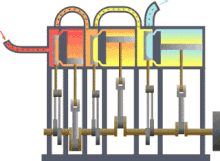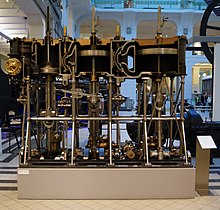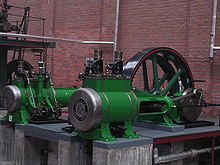
Back Sdružený parní stroj Czech Verbunddampfmaschine German Motor de vapor compuesto Spanish Motrice alternativa Italian 複式蒸気機関 Japanese Silnik sprzężony Polish Компаунд-машина Russian Kompoundångmaskin Swedish เครื่องจักรไอน้ำแบบผสม Thai Bileşik buhar motoru Turkish

High-pressure steam (red) passes through three stages, exhausting as low-pressure steam (blue) to the condenser


small high-pressure cylinder (left) and large low-pressure cylinder (right)
A compound steam engine unit is a type of steam engine where steam is expanded in two or more stages.[1][2] A typical arrangement for a compound engine is that the steam is first expanded in a high-pressure (HP) cylinder, then having given up heat and losing pressure, it exhausts directly into one or more larger-volume low-pressure (LP) cylinders. Multiple-expansion engines employ additional cylinders, of progressively lower pressure, to extract further energy from the steam.[3]
Invented in 1781, this technique was first employed on a Cornish beam engine in 1804. Around 1850, compound engines were first introduced into Lancashire textile mills.
- ^ van Riemsdijk, John (1970), "The Compound locomotive, Parts 1, 2, 3", Transactions of the Newcomen Society (2)
- ^ Van Riemsdijk 1994, pp. 4–9.
- ^ Hills (1989), p. 147.